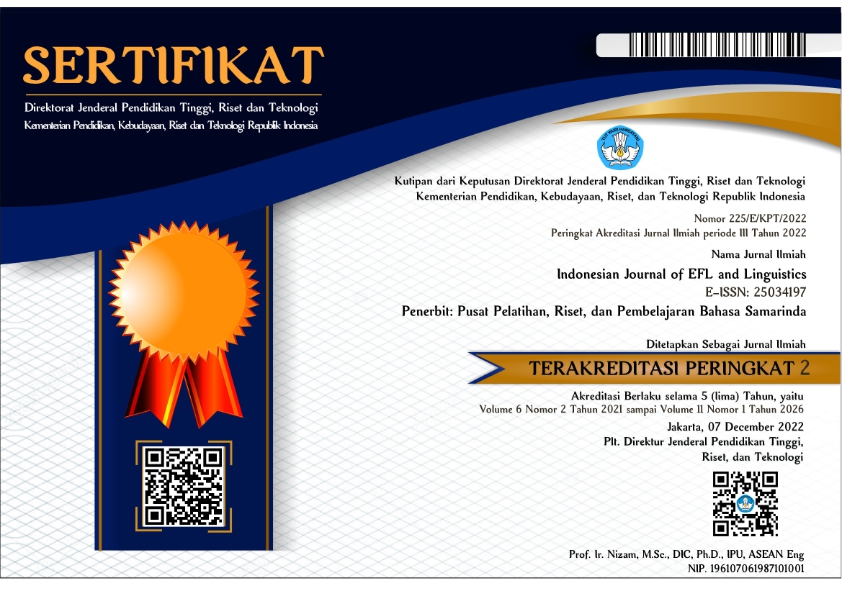The Representation of Social Actors in EFL Textbooks: Systemic Functional Linguistics Perspective
Abstract
Systemic Functional Linguistics (SFL) has gained popularity as a linguistic theory, especially in the field of education where it provides a useful method for examining textbooks. The goal of this study is to examine how social actors are portrayed in a particular textbook utilizing SFL framework. Textual data were gathered from a sample of the textbook, and transitivity patterns of process categories and pronoun usage were used to analyze the data. The results revealed that the pronoun "he" was primarily utilized and that the material process, which denotes physical actions, was most commonly used, depicting men as the main actors. These results imply that the texts in the textbook reflect how social actors are portrayed and represented in speech and offer an understanding of their functions, choices, agency, and relations
References
Alshenqeeti, H. 2019. Representation of Culture in EFL Textbooks and Learners’ Preference, Pedagogy Journal of English Language Teaching, 7(2),127-135. 10.32332/pedagogy.v7i2.1647
Andersen, T. H., Emilie, A., & Holsting, M. (2018). Clause Complexing in Systemic Functional Linguistics –towards an Alternative Description. Functional Linguistics, 5(10), 1–25. https://doi.org/https://doi.org/10.1186/s40554-018-0059-7.
Briones, R. R. Y. (2016). Textual Analysis through Systemic Functional Linguistics. Journal of English Language Teaching and Linguistics (JELTL), 1(2), 109–144. http://dx.doi.org/10.21462/jeltl.v1i2.27
Chan, J. Y. H. (2013). The Role of Situational Authenticity in English Language Textbooks. RELC Journal, 44(3), 303–317. https://doi.org/10.1177/0033688213500583
Chu, Y. (2015). The Power of Knowledge : A Critical Analysis of the Depiction of Ethnic Minorities in China ’ s Elementary Textbooks. Race Ethnicity and Education, 18(4), 469–487. https://doi.org/http://dx.doi.org/10.1080/13613324.2015.1013460 The
Chun, C. W. (2016). Addressing Racialized Multicultural Discourses in an EAP Textbook : Working Toward a Critical Pedagogies Approach. Tesol Quarterly, 50(1), 109–131. https://doi.org/10.1002/tesq.216
Cicilia, T. (2017). The Analysis of Indonesian Students’ English Textbook and Thai Students’ English Textbooks. J-ELLiT(Journal of English Language, Literature, and Teaching), 1(2), 10–16. Retrieved from http//journal2.um.ac.id/index.php/jellit
Darong, H. C. (2021). From Clause to Function: Texts Analysis Using Systemic Functional Linguistics Theory and Its Pedagogical Implication in Language Teaching. Indonesian Journal of EFL and Linguistics, 6(1), 29–46. https://doi.org/http://dx.doi.org/10.21462/ijefl.v6i1.337
Darong, H. C., Menggo, S., & Jelimun, M. O. (2022). A Comparative Analysis (Discourse Semantic Analysis on the Political Speech based on Systemic Functional Linguistics Theory). Nyimak Journal of Communication, 6(2), 207–227 https://jurnal.untad.ac.id/jurnal/index.php/NJOC/article/view/24050/13467
Darong, H.C, Jem, Y.H. & Guna, S. 2022. Lexical Cohesion Devices in Students’ Narrative Text and Its Pedagogical Implication in Language Teaching: A Discourse-Semantics Point of View. Jurnal Pendidikan Progresif, 12(1), 362-374. doi: 10.23960/jpp.v12.i1.202228
Davidson, R., & Liu, Y. (2018). Reaching the World Outside: Cultural Representation and Perceptions of Global Citizenship in Japanese Elementary School English Textbooks, Language, Culture and Curriculum, 33(1), 1–19. https://doi.org/10.1080/07908318.2018.1560460
Eggins, S. (1994). An Introduction to Systemic Functional Linguistics. London: Pinter.
Fairclough, N. (2010). Critical discourse analysis: The critical study of language (2nd ed.). Routledge.
Halliday, M. A. . (1985). Introduction to Functional Grammar. London: Edward Arnold.
Halliday, M. A. K., & Matthiessen, C. M. I. M. (2014). An introduction to functional grammar (4th ed.). Routledge.
Hall, M. 2014. Gender Representation in Current EFL Textbooks in Iranian Secondary Schools. Journal of Language Teaching and Research, 5(2), 253-261. doi:10.4304/jltr.5.2.253-261
Jamalipour, S. & Farahani, A.A.K. 2015. The Effect of Vocabulary Knowledge and Background Knowledge on Iranian EFL Learners’ L2 Reading Comprehension. Journal of Applied Linguistics and Language Research, 2(2), 107-121. https://www.jallr.com/index.php/JALLR/article/view/855
Kusuma, R., Dewi, S., & Kurniawan, E. (2018). Seeing Recount from Systemic Functional Linguistic Perspective: Sine Qua Non Attributes. RETORIKA: Jurnal Ilmu Bahasa, 4(1), 43–52. https://doi.org/ 10.22225/jr.4.1.464.43-52.
Limberg, H. (2016). Teaching How to Apologize : EFL Textbooks and Pragmatic Input. Language Teaching Research, 20(6), 700–718. https://doi.org/10.1177/1362168815590695
Mahmud, Y. S. (2019). The Representation of Local Culture in Indonesian EFL Textbooks: Rationales and Implications. Indonesian EFL Journal (IEFLJ), 5(2), 61–72. https://doi.org/10.25134/ieflj.v5i2.1727.
Meihami, H., & Khanlarzadeh, M. (2015). Pragmatic Content in Global and Local ELT Textbooks : A Micro Analysis Study. SAGE Open, 1–10. https://doi.org/10.1177/2158244015615168
Montes, P. A., Barboza, A. M. ., & Olascoaga, A. I. . (2014). Systemic Functional Linguistics and Discourse Analysis as Alternatives When Dealing With Texts. Profile, 16(2), 101–116. https://doi.org/http://dx.doi.org/10.15446/profile.v16n2.38113.
Nagatomo, D. H. 2010. A Critical Analysis of Gender Representation in anEFL Textbook. Journal of the Ochanomizu University EnglishSociety. Journal of the Ochanomizu University English Society, 1,53-61. http://hdl.handle.net/10083/49643
Nowell, L. S., Norris, J. M., White, D. E., & Moules, N. J. (2017). Thematic Analysis :Striving to Meet the Trustworthiness Criteria. International Journal of Qualitative Method, 16(1), 1–13. https://doi.org/10.1177/1609406917733847
Pan, M.X. & Zhu, Y.2022. Researching English language textbooks: A systematic review in the Chinese context (1964–2021). Asian. J. Second. Foreign. Lang. Educ, 7(30), 1-17. https://doi.org/10.1186/s40862-022-00156-3
Rezeq, K.A.K.A. 2022. Evaluating the Palestinian’s English as a Foreign Language (EFL) Textbooks of the Secondary Stage Using Textbooks Evaluation Standards. Journal of Educational Sciences, 20, 177-198. https://doi.org/10.29117/jes.2022.0093
Setyono, B., & Widodo, H. P. (2019). The representation of Multicultural Values in the Indonesian Ministry of Education and Culture- Endorsed EFL Textbook: A Critical Discourse Analysis. Intercultural Education, 30(4), 383–397. https://doi.org/10.1080/14675986.2019.1548102
Shin, J., Eslami, Z. R., & Chen, W. (2011). Presentation of local and international culture in Current International English-language Teaching Textbooks. Language, Culture and Curriculum, 24(3), 253–268. https://doi.org/http://dx.doi.org/10.1080/07908318.2011.614694 PLEASE
Siegel, A. (2014). What should we talk about ? The authenticity of textbook topics. ELT Journal, 68(4), 363–375. https://doi.org/10.1093/elt/ccu012
Copyright (c) 2023 Indonesian Journal of EFL and Linguistics

This work is licensed under a Creative Commons Attribution-NonCommercial-ShareAlike 4.0 International License.




